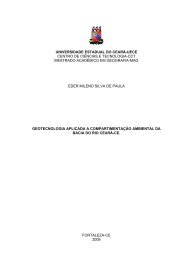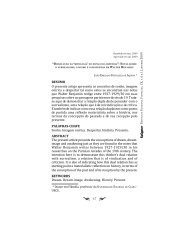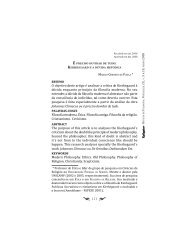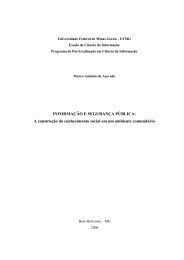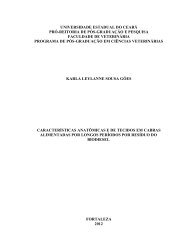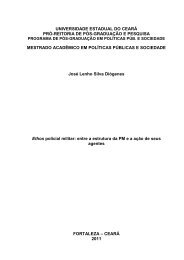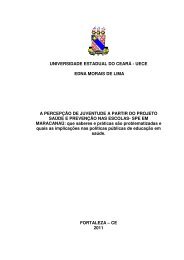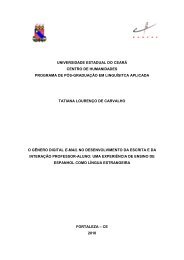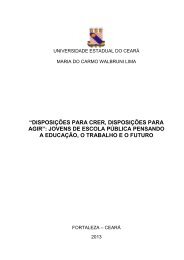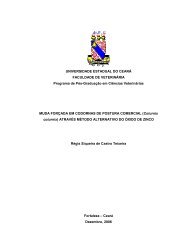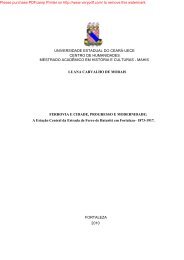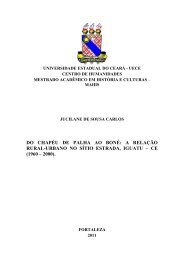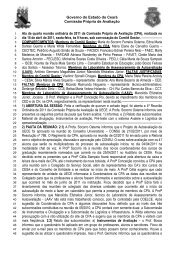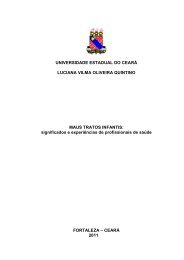OVICIDAL AND LARVICIDAL ACTIVITY OF Cocos nucifera L ... - Uece
OVICIDAL AND LARVICIDAL ACTIVITY OF Cocos nucifera L ... - Uece
OVICIDAL AND LARVICIDAL ACTIVITY OF Cocos nucifera L ... - Uece
Create successful ePaper yourself
Turn your PDF publications into a flip-book with our unique Google optimized e-Paper software.
Ciência Animal 21(2):87-95, 2011<br />
<strong>OVICIDAL</strong> <strong>AND</strong> <strong>LARVICIDAL</strong> <strong>ACTIVITY</strong> <strong>OF</strong> <strong>Cocos</strong> <strong>nucifera</strong> L. EXTRACTS ON<br />
Haemonchus contortus<br />
(Atividade ovicida e larvicida de extratos de <strong>Cocos</strong> <strong>nucifera</strong> L. sobre Haemonchus contortus)<br />
Cícero Temístocles Coutinho COSTA 1 , Claudia Maria Leal BEVILAQUA 2* , Selene Maia<br />
de MORAIS 2 , Lorena Mayana Beserra de OLIVEIRA 2 , Ana Lourdes Fernandes<br />
CAMURÇA-VASCONCELOS 2 , Michelline do Vale MACIEL 2 ,Karisia Sousa Barros de<br />
LIMA 2<br />
1.Laboratório Nacional Agropecuário/Ministério da Agricultura, Pecuária e Abastecimento;<br />
2. Programa de Pós-Graduação em Ciências Veterinárias/Faculdade de Veterinária da<br />
Universidade Estadual do Ceará.<br />
ABSTRACT<br />
The nematodes control is carried out with anthelmintics, but the development of resistance has<br />
required the search for alternatives such as medicinal plants. There are popular reports of antiparasitic<br />
activity of <strong>Cocos</strong> <strong>nucifera</strong> fruit. The purpose of this study was to evaluate the ovicidal and larvicidal<br />
activity of the liquid of green coconut husk fiber (LGCHF) and butanol extract obtained from<br />
LGCHF on Haemonchus contortus and investigate the chemical compounds present in these extracts.<br />
The in vitro assay was based on egg hatching (EHT) and larval development tests (LDT). The<br />
LGCHF concentrations tested in EHT ranged from 0.15 to 2.5 mg/mL, while in the LDT varied<br />
from 2.5 to 40 mg/mL. The LGCHF butanol extract concentrations used in EHT ranged from 4.06<br />
to 65 mg/mL, whilst in the LDT varied from 5 to 80 mg/mL. The LGCHF and butanol extract<br />
showed 100% ovicidal efficacy at 2.5 and 10 mg/mL, respectively. In higher concentrations, the<br />
larvicidal effect of LGCHF and butanol extract was 81.30 and 99.80%, respectively. Phytochemical<br />
tests revealed the presence of triterpenes, saponins and condensed tannins. These results suggest<br />
the coconut extracts can be useful in gastrointestinal nematodes control of small ruminants. However,<br />
toxicological evaluation and in vivo studies are still necessary.<br />
KEYWORDS: coconut, in vitro, gastrointestinal nematodes, sheep, goats.<br />
RESUMO<br />
O controle de nematóides é realizado com anti-helmínticos, mas o desenvolvimento da resistência<br />
tem exigido a busca por alternativas como as plantas medicinais. Existem relatos populares da<br />
atividade antiparasitária do fruto de <strong>Cocos</strong> <strong>nucifera</strong>. O objetivo desse estudo foi avaliar a atividade<br />
ovicida e larvicida do líquido da casca do coco verde (LCCV) e do extrato butanólico obtido a<br />
partir do LCCV sobre Haemonchus contortus e investigar os compostos químicos presentes nesses<br />
extratos. A avaliação in vitro foi baseada nos testes de eclosão de ovos (TEO) e desenvolvimento<br />
larvar (TDL). As concentrações de LCCV avaliadas no TEO variaram de 0,15 a 2,5 mg/mL, enquanto<br />
no TDL foram de 2,5 a 40 mg/mL. As concentrações do extrato butanólico do LCCV testadas no<br />
TEO variaram de 4,06 a 65 mg/mL, enquanto no TDL foram de 5 a 80 mg/mL. O LCCV e o extrato<br />
butanólico apresentaram 100% de eficácia ovicida nas concentrações de 2,5 e 10 mg/mL,<br />
respectivamente. Nas maiores concentrações, o efeito larvicida do LCCV e do extrato butanólico<br />
* Corresponding author:<br />
C. M. L. Bevilaqua, Av. Paranjana, 1700, Itaperi<br />
CEP 60740-000, Fortaleza, Ceará, Brazil<br />
E-mail: claudia.bevilaqua@pesquisador.cnpq.br<br />
Ciência Animal 21(2):87-95, 2011 87
foi de 81,30 e 99,80%, respectivamente. Os testes fitoquímicos revelaram a presença de triterpenos,<br />
saponinas e taninos condensados. Esses resultados sugerem que extratos do coco podem ser úteis<br />
no controle de nematóides gastrintestinais de pequenos ruminantes. Entretanto, estudos toxicológicos<br />
e uma avaliação anti-helmíntica in vivo ainda são necessários.<br />
PALAVRAS-CHAVE: coco, in vitro, nematóides gastrintestinais, ovinos, caprinos.<br />
INTRODUCTION<br />
Gastrointestinal nematode parasites are<br />
the main cause of mortality in sheep and goats<br />
in northeastern Brazil. The nematode of greater<br />
prevalence in this region is Haemonchus<br />
contortus (Arosemena et al., 1999). This parasite<br />
infection may result in high losses in yielding<br />
profit because this nematode leads to a<br />
depression of appetite, changes in protein, energy<br />
and mineral metabolism. However, the main<br />
symptom of H. contortus infection is anemia due<br />
to hematophagy. It is estimated that the average<br />
blood loss by this parasite is 0.05 ml a day<br />
(Soulsby, 1987).<br />
Sheep and goats gastrointestinal<br />
nematodes control is usually accomplished with<br />
anthelmintic treatment. However the<br />
development of resistant gastrointestinal<br />
nematode populations (Melo et al., 2003) is one<br />
of the most important and current problem in<br />
animal husbandry. The anthelmintics available<br />
in the trade have some limitations, such as high<br />
costs, residues in food (Herd, 1995), risk of<br />
environmental pollution and reduced efficacy in<br />
the production of sheep and goats due to low<br />
effectiveness. Considering these problems,<br />
alternatives such as phytotherapy can be used to<br />
decrease the use of synthetic products.<br />
<strong>Cocos</strong> <strong>nucifera</strong> L. is a plant commonly<br />
found along the northeastern coast of Brazil,<br />
whose fruit is the coconut. The main use of<br />
coconut is the extraction of water that is well<br />
appreciated by the flavor and nutritional qualities<br />
(Senhoras, 2003). Moreover, an extensive range<br />
of popular medicinal uses of this plant has been<br />
reported. The decoction of the coconut husk ber<br />
has been used in northeastern Brazil as a<br />
88<br />
Ciência Animal 21(2):87-95, 2011<br />
traditional medicine to treat diarrhea, arthritis,<br />
bleeding and hemorrhages (Esquenazi et al.,<br />
2002; Mendonça-Filho et al., 2004). The liquid<br />
extracted from the coconut husk ber has in vitro<br />
antiproliferative, analgesic and antioxidant<br />
characteristics (Kirsberg et al., 2003; Alviano et<br />
al., 2004). The ethyl acetate extract obtained from<br />
the liquid of coconut husk ber showed in vitro<br />
antibacterial, antiviral, leishmanicidal<br />
(Esquenazi et al., 2002; Mendonça-Filho et al.,<br />
2004) and anthelmintic (Oliveira et al., 2009)<br />
activities. The objective of this study was to<br />
evaluate the ovicidal and larvicidal activity of<br />
the liquid of green coconut husk fiber (LGCHF)<br />
and butanol extract obtained from LGCHF on<br />
H. contortus and investigate the chemical<br />
compounds present in these extracts.<br />
MATERIALS <strong>AND</strong> METHODS<br />
Plant material and extract preparation<br />
The LGCHF provided by Empresa<br />
Brasileira de Pesquisa Agropecuária<br />
(EMBRAPA)/Agroindústria Tropical was<br />
obtained from coconut collected in fruit industry<br />
localized in Fortaleza, Ceará, Brazil. The green<br />
coconut husk fiber was crushed, pressed and<br />
filtered to obtain the LGCHF. To obtain the<br />
butanol extract, the LGCHF was filtered and<br />
subjected to three washes with solvents in 10:1<br />
proportion using a decantation funnel. Initially,<br />
ethyl acetate was used and then butyl alcohol<br />
(butanol). The butanol solvent was eliminated<br />
in a rotary evaporator to produce the LGCHF<br />
butanol extract. To perform the tests, the LGCHF<br />
and butanol extract were diluted in distilled water<br />
and 3% dimethylsulfoxide (DMSO),<br />
respectively.
Phytochemical study<br />
Phytochemical tests to detect the presence<br />
of phenols, tannins, leucoantocianidins,<br />
flavonoids, steroids, triterpens and alkaloids were<br />
performed in LGCHF and butanol extract<br />
according to Matos (1997) methodology. These<br />
tests are based on visual observation of color<br />
modification or formation of precipitates after<br />
specific reagents addition.<br />
In the Lieberman-Burchard test, a<br />
chloroform solution of the extracts (2 mL) is<br />
mixed with acetic anhydride (1 mL) and three<br />
drops of concentrated sulfuric acid. The<br />
development of a blue to green color indicates<br />
the presence of steroids and a red to brown color<br />
is indicative of triterpenoids. Alcoholic extracts<br />
(3 mL) in presence of an alcoholic FeCl 3<br />
solution<br />
produce a dark blue precipitate in the presence<br />
of hydrolysable tannins and a green precipitate<br />
in the presence of condensed tannins or catechins.<br />
To evaluate the presence of alkaloids, the extracts<br />
were mixed with NH 4<br />
OH until pH 11 and the<br />
bases were extracted three times with diethyl<br />
ether–chloroform solution (3 + 1). In a separation<br />
funnel the organic layer was washed three times<br />
with HCl solution (0.1 M). The aqueous acid<br />
solution was divided into three portions and<br />
transferred to test tubes for adding the reagents<br />
which precipitate alkaloids: Hager (saturated<br />
solution of picric acid), Mayer (aqueous solution<br />
of mercuric chloride and potassium iodide) and<br />
Dragendorff (aqueous solution of bismutilcarbonate,<br />
hydrochloric acid and potassium<br />
iodide).<br />
Total tannins quantification<br />
The quantification of total tannins was<br />
performed in LGCHF and butanol extract<br />
according to Pansera et al. (2003). We used 5<br />
mg of LGCHF and butanol extract diluted in 50<br />
mL of distilled water. At a rate of 2 mL was added<br />
2 mL of the Folin-Denis reagent and the resulting<br />
solution was shaken vigorously, left at rest for 3<br />
minutes. After, 2 mL 8% sodium carbonate was<br />
added to the solution, agitated and left at rest for<br />
2 hours, followed by centrifugation at 2000 rpm<br />
for 10 minutes. Quantification total tannins was<br />
performed using as standard the tannic acid. Thus<br />
prepared to be a pattern curve of tannic acid using<br />
4, 6, 8, 10, 12 and 14 ppm of tannic acid diluted<br />
with water. The absorbance was measured at 720<br />
nm, and a negative control was used for each<br />
reading. From the results the calibration curve<br />
was built and used for calculating total tannins.<br />
The readings were made in a spectrophotometer<br />
Spekol 1100. Three replicates were performed<br />
for each sample.<br />
In vitro assays<br />
One sheep was maintained in a metabolic<br />
cage and treated with three anthelmintics of<br />
different active principles on alternate days. After<br />
complete natural infection elimination, 5.000 H.<br />
contortus third-stage larvae (L3) were orally<br />
administered. This animal was used as a source<br />
of H. contortus eggs and larvae. For egg recovery<br />
approximately 10 g of feces were collected<br />
directly from the rectum of this animal and<br />
processed according to the technique described<br />
by Hubert & Kerboeuf (1992). The recovered<br />
eggs were dispersed in distilled water. To obtain<br />
the first-stage larvae (L1), an aliquot of egg<br />
suspension was incubated during 24 h at 37°C.<br />
The egg hatching test (EHT) was based<br />
on the method described by Coles et al. (1992).<br />
A 0.25 mL of suspension containing<br />
approximately 100 fresh eggs was distributed in<br />
5 mL tubes and incubated with the same volume<br />
of LGCHF or butanol extract at room<br />
temperature. The LGCHF concentrations used<br />
were 0.15, 0.31, 0.62, 1.25 and 2.5 mg/mL, while<br />
the butanol extract concentrations were 2.5, 5,<br />
10, 20 and 40 mg/mL. After 48 h, lugol drops<br />
were added to stop the egg hatching. All eggs<br />
and L1 were counted under a microscope. This<br />
test was accompanied by two controls: a<br />
Ciência Animal 21(2):87-95, 2011 89
negative, containing distilled water to the<br />
LGCHF or containing 3% DMSO to the butanol<br />
extract, and a positive with 0.025 mg/mL<br />
thiabendazole. Three repetitions with five<br />
replicates were performed for each extract<br />
concentration and control.<br />
The larval development test (LDT) was<br />
based on the method described by Camurça-<br />
Vasconcelos et al. (2007). A 1 mL suspension<br />
containing approximately 300 L1 and the same<br />
volume of LGCHF or butanol extract were<br />
incubated with 2 g of feces from a sheep free of<br />
gastrointestinal nematodes at room temperature.<br />
The final concentrations of LGCHF used were<br />
4.06, 8.12, 16.25, 32.5 and 65 mg/mL, while the<br />
butanol extract concentrations were 5, 10, 20,<br />
40 and 80 mg/mL. After an incubation period of<br />
6 days the L3 were recovered (Roberts &<br />
O’Sullivan, 1950) and counted under a<br />
microscope. This test was accompanied by two<br />
controls: a negative, containing distilled water<br />
to the LGCHF or containing 3% DMSO to the<br />
butanol extract, and a positive with 0.64 μl/mL<br />
ivermectin. Three repetitions with five replicates<br />
were performed for each extract concentration<br />
and control.<br />
Statistical analysis<br />
In the ETH, the efficacy of each treatment<br />
was calculated by the equation: L1/(eggs + L1)<br />
x 100, while in the LDT the formula used was:<br />
(L3 in the negative control group - L3 in the<br />
treated group)/ L3 in the negative control group<br />
x 100. The results were analyzed by ANOVA and<br />
Tukey test (P
Table 2. Mean efficacy (percentage ± S.D.) of butanol extract obtained from the liquid of<br />
green coconut husk fiber (LGCHF) on H. contortus egg hatching.<br />
Treatment Concentration Mean efficacy ± S.D.<br />
LGCHF butanol extract<br />
LGCHF butanol extract<br />
LGCHF butanol extract<br />
LGCHF butanol extract<br />
LGCHF butanol extract<br />
Thiabendazole<br />
Dimethylsulfoxide<br />
40 mg/mL<br />
20 mg/mL<br />
10 mg/mL<br />
5 mg/mL<br />
2.5 mg/mL<br />
0.025 mg/mL<br />
3%<br />
100.00 ± 0.0 a<br />
100.00 ± 0.0 a<br />
100.00 ± 0.0 a<br />
81.43 ± 7.90 b<br />
13.93 ± 4.49 c<br />
99.48 ± 0.66 a<br />
4.63 ± 1.73 d<br />
Different letters indicate significantly difference (P
52.63) mg/mL and 32.52 (18.94-60.20) mg/mL,<br />
respectively.<br />
DISCUSSION<br />
This work evaluated in vitro the activity<br />
of the LGCHF trying to select a substance that<br />
can be used in gastrointestinal nematodes control.<br />
LGCHF and butanol extract presented ovicidal<br />
and larvicidal activity demonstrating the<br />
existence of chemical constituents with<br />
effectiveness on H. contortus. The 100% ovicidal<br />
effect of LGCHF in a low concentration (2.5 mg/<br />
mL) was better than butanol and ethyl acetate<br />
extracts which in the same concentration were<br />
only 13.93% and 68.45% effectiveness (Oliveira<br />
et al., 2009). LGCHF also was more effective<br />
than other plants extracts with anthelmintic effect<br />
as seed hexane extract of Mangifera indica<br />
(Costa et al., 2002), leaf hexane, chloroform,<br />
ethyl acetate and methanol extracts of Spigelia<br />
anthelmia (Assis et al., 2003), Acacia mearnsii<br />
(Minho, 2006), leaf hexane and ethanol extracts<br />
of Melia azedarach (Maciel et al., 2006) and leaf<br />
ethyl acetate and ethanol extracts of Azadirachta<br />
indica (Costa et al., 2008). This result can be<br />
attributed to combination of active compounds<br />
resulting in a synergistic effect (Rates, 2001). But<br />
the action mechanism involved in ovicidal effect<br />
is unknown.<br />
The tannins found in LGCHF and butanol<br />
extract are associated with natural defense of<br />
plants against insects, and classified according<br />
to their properties and chemical structure in<br />
hydrolysable and condensed tannins<br />
(Athanasiadou et al., 2001). Several results<br />
suggest that condensed tannins, among the<br />
various secondary metabolic present in plants and<br />
fodder, are compounds with potential<br />
anthelmintic activity. The use of quebracho<br />
(Schinops sp) extract, containing 73% of<br />
condensed tannins (Athanasiadou et al., 2001)<br />
and acacia-negra (Acacia mearnsii) extract with<br />
15% of condensed tannins (Minho, 2006)<br />
inhibited in vitro the larvae viability of H.<br />
contortus, Teladorsagia circumcincta and<br />
Trichostrongylus vitrinus. Moreover, it was<br />
observed that monomers of condensed tannins<br />
were responsible for decrease of the egg hatching,<br />
larval development and viability of infective<br />
Table 4. Mean efficacy (percentage ± S.D.) of butanol extract obtained from the liquid of<br />
green coconut husk fiber (LGCHF) on H. contortus larval development.<br />
Treatment Concentration Mean efficacy ± S.D.<br />
LGCHF butanol extract<br />
80 mg/mL<br />
99.80 ± 0.29 a<br />
LGCHF butanol extract<br />
LGCHF butanol extract<br />
LGCHF butanol extract<br />
LGCHF butanol extract<br />
Ivermectin<br />
Dimethylsulfoxide<br />
40 mg/mL<br />
20 mg/mL<br />
10 mg/mL<br />
5 mg/mL<br />
0.64 μl/mL<br />
3%<br />
62.33 ± 10.64 b<br />
13.19 ± 2.97 c<br />
2.39 ± 2.42 d<br />
0.95 ± 1.30 d<br />
99.98 ± 0.06 a<br />
1.10 ± 1.20 d<br />
92<br />
Different letters indicate significantly difference (P
larvae of Trichostrongylus colubriformis (Molan<br />
et al., 2003). The antiparasitic activity of these<br />
metabolites is attributed to its ability to bind to<br />
the free protein available for larvae nutrition;<br />
reduced nutrient availability could have resulted<br />
in larvae starvation and death (Athanasiadou et<br />
al., 2001). Schultz (1989) reported that in insects<br />
and insect larvae that ingest the condensed<br />
tannins occurs connection of these compounds<br />
with intestinal mucosa causing autolysis, leading<br />
to an inability to use nutrients by the larva. This<br />
mechanism could be condensed tannins mode of<br />
action on nematodes larvae. Furthermore, these<br />
metabolites have the ability to link protein, as<br />
proline and hydroxyproline, in the cuticle, oral<br />
cavity, esophagus, cloaca and vulva of the<br />
nematode that would result in a structural parasite<br />
change causing its death (Hoste et al., 2006).<br />
The phytochemical tests revealed the<br />
presence of chemical constituents that may be<br />
responsible for anthelmintic activity found.<br />
Among those constituents, it was detected the<br />
presence of triterpenoids and saponins but no<br />
relevant anthelmintic effect was reported.<br />
Though the LGCHF ethyl acetate extract<br />
had showed in vivo no activity against sheep<br />
gastrointestinal nematodes (Oliveira et al., 2009),<br />
the results found in this study demonstrate the<br />
possibility of using LGCHF and LGCHF butanol<br />
extract against gastrointestinal parasites of small<br />
ruminants, because although the extracts have<br />
the same origin, the composition is different.<br />
However, more detailed studies are needed to<br />
verify the toxicity, and to evaluate the effects in<br />
vivo and establish the adequate doses for sheep<br />
and goats.<br />
ACKNOWLEDGMENTS<br />
This study received financial support<br />
from the National Research Council (CNPq). Dr.<br />
Bevilaqua has a CNPq research grant. We would<br />
like to thank Dr. Morsyleide de Freitas Rosa of<br />
EMBRAPA/Agroindústria Tropical for providing<br />
of the LGCHF.<br />
REFERENCES<br />
ALVIANO, D.S.; RODRIGUES, K.F.; LEITÃO,<br />
S.G.; RODRIGUES, M.L.; MATHEUS, M.E.;<br />
FERN<strong>AND</strong>ES, P.D.; ANTONIOLLI, A.R.,<br />
ALVIANO, C.S. Antinociceptive and free radical<br />
scavenging activities of <strong>Cocos</strong> <strong>nucifera</strong> L.<br />
(Palmae) husk fiber aqueous extract. Journal of<br />
Ethnopharmacology, v. 92, p. 269-273, 2004.<br />
AROSEMENA, N.A.E.; BEVILAQUA, C.M.L.;<br />
GIRÃO MD; MELO, A.C.F.L. Seasonal<br />
variations of gastrointestinal nematodes in sheep<br />
and goats from semi-arid area in Brazil. Revista<br />
de Medicina Veterinária, v. 150, p. 873-876,<br />
1999.<br />
ASSIS, L.M.; BEVILAQUA, C.M.L.; MORAIS,<br />
S.M.; VIEIRA, L.S.; COSTA, C.T.C.; SOUZA,<br />
J.A.L. Ovicidal and larvicidal activity in vitro of<br />
Spigelia anthelmia Linn extracts on Haemonchus<br />
contortus. Veterinary Parasitology, v. 117, p. 43-<br />
49, 2003.<br />
ATHANASIADOU, S.; KYRIAZAKIS, I.;<br />
JACKSON, F.; COOP, R.L. Direct anthelmintic<br />
effects of condensed tannins towards different<br />
gastrointestinal nematodes of sheep: in vitro and<br />
in vivo studies. Veterinary Parasitology, v. 99,<br />
p. 205-219, 2001.<br />
CAMURÇA-VASCONCELOS, A.L.F.;<br />
BEVILAQUA, C.M.L; MORAIS, S.M.;<br />
MACIEL, M.V.; COSTA, C.T.C.; MACEDO,<br />
I.T.F.; OLIVEIRA, L.M.B.; BRAGA, R.R.;<br />
SILVA, R.A.; VIEIRA, L.S. Anthelmintic activity<br />
of Croton zehntneri and Lippia sidoides essential<br />
oils. Veterinary Parasitology, v. 148, v. 288-294,<br />
2007.<br />
COLES, G.C.; BAUER, C.; BORGSTEEDE,<br />
F.H.M.; GEERTS, S.; KLEI, T.R.; TAYLOR,<br />
M.A.; WALLER, P.J. World Association for the<br />
Advancement of Veterinary Parasitology<br />
(W.A.A.V.P.). Methods for the detection of<br />
Ciência Animal 21(2):87-95, 2011 93
anthelmintic resistance in nematodes of<br />
veterinary importance. Veterinary Parasitology,<br />
v. 44, p. 35-44, 1992.<br />
COSTA, C.T.C.; MORAIS, S.M.;<br />
BEVILAQUA, C.M.L.; SOUZA, M.M.C.;<br />
LEITE, F.K.A. Efeito ovicida de extratos de<br />
sementes de Mangifera indica L. sobre<br />
Haemonchus contortus. Revista Brasileira de<br />
Parasitologia Veterinária, v. 11, p. 57-60, 2002.<br />
COSTA, C.T.C.; BEVILAQUA, C.M.L.;<br />
CAMURÇA-VASCONCELOS, A.L.F.;<br />
MACIEL, M.V.; MORAIS, S.M.; CASTRO,<br />
C.M.S.; BRAGA, R.R.; OLIVEIRA, L.M.B. In<br />
vitro ovicidal and larvicidal activity of<br />
Azadirachta indica extracts on Haemonchus<br />
contortus. Small Ruminant Research, v. 74, p.<br />
284-287, 2008.<br />
ESQUENAZI, D.; WIGG, M.D.; MIR<strong>AND</strong>A,<br />
M.M.F.S.; RODRIGUES, H.M.; TOSTES,<br />
J.B.F.; ROZENTAL, S.; SILVA, A.J.R.;<br />
ALVIANO, C.S. Antimicrobial and antiviral<br />
activities of polyphenolics from <strong>Cocos</strong> <strong>nucifera</strong><br />
Linn. (Palmae) husk fiber extract. Research in<br />
Microbiology, v. 153, p. 647-652, 2002.<br />
HERD, P.R. Impactos ambientais associados aos<br />
compostos endectocidas. In: Padilha T. Controle<br />
dos nematódeos gastrintestinais em<br />
ruminantes. Juiz de Fora, 1995. p 95-111.<br />
HOSTE H, JACKSON F, ATHANASIADOU S,<br />
THAMSBORG SM, HOSKIN SO The effects<br />
of tannin-rich plants on parasitic nematodes in<br />
ruminants. Trends in Parasitology, v. 22, p. 253-<br />
261, 2006.<br />
HUBERT, J.; KERBOEUF, D. A microlarval<br />
development assay for the detection of<br />
anthelmintic resistance in sheep nematodes.<br />
Veterinary Record, v. 130, p. 442-446, 1992.<br />
KIRSZBERG, C.; ESQUENAZI, D.; ALVIANO,<br />
C.S.; RUMJANEKA, V.M. The effect of a<br />
catechin-rich extract of <strong>Cocos</strong> <strong>nucifera</strong> on<br />
lymphocytes proliferation. Phytotherapy<br />
Research, v. 17, p. 1054-1058, 2003.<br />
MACIEL, M.V; MORAIS, S.M.; BEVILAQUA,<br />
94<br />
Ciência Animal 21(2):87-95, 2011<br />
C.M.L.; CAMURÇA-VASCONCELOS, A.L.F.;<br />
COSTA, C.T.C.; CASTRO, C.M.S. Ovicidal and<br />
larvicidal activity of Melia azedarach extracts<br />
on Haemonchus contortus. Veterinary<br />
Parasitology, v. 140, p. 98-104, 2006.<br />
MATOS, S.G.A. Introdução à fitoquímica<br />
Experimental. Fortaleza: Edições UFC, 1997.<br />
MELO, A.C.F.L.; REIS, I.F.; BEVILAQUA,<br />
C.M.L.; VIEIRA, L.S.; ECHEVARRIA, F.A.M.;<br />
MELO, L.M. Nematódeos resistentes a antihelmínticos<br />
em rebanhos de ovinos e caprinos<br />
do estado do Ceará, Brasil. Ciência Rural, v. 33,<br />
p. 339-44, 2003.<br />
MENDONÇA-FILHO, R.R.; RODRIGUES,<br />
I.A.; ALVIANO, D.S.; SANTOS, A.L.S.;<br />
SOARES, R.M.A.; ALVIANO, C.S.; LOPES,<br />
A.H.C.S.; ROSA, M.S.S. Leishmanicidal activity<br />
of polyphenolics-rich extract from husk fiber of<br />
<strong>Cocos</strong> <strong>nucifera</strong> Linn. (Palmae). Research in<br />
Microbiology, v. 155, p.136-143, 2004.<br />
MINHO, A.P. Efeito anti-helmíntico de taninos<br />
condensados sobre nematódeos<br />
gastrintestinais em ovinos. 2006. Dissertação -<br />
Centro de Energia Nuclear na Agricultura,<br />
Universidade de São Paulo.<br />
MOLAN, A.L.; MEAGHER, L.P.; SPENCER,<br />
P.A.; SIVAKUMARAN, S. Effect of flavan-3-<br />
ols on in vitro egg hatching, larval development<br />
and viability of infective larvae of<br />
Trichostrongylus colubriformis. International<br />
Journal of Parasitology, v. 33, p. 1691-1698,<br />
2003.<br />
OLIVEIRA, L.M.B.; BEVILAQUA, C.M.L.;<br />
COSTA, C.T.C.; MACEDO, I.T.F.; BARROS,<br />
R.S.; RODRIGUES, A.C.M.; CAMURÇA-<br />
VASCONCELOS, A.L.F.; MORAIS, S.M.;<br />
LIMA, Y.C.; VIEIRA, L..; NAVARRO, A.M.C.<br />
Anthelmintic activity of <strong>Cocos</strong> <strong>nucifera</strong> L.<br />
against sheep gastrointestinal nematodes.<br />
Veterinary Parasitology, v. 159, p. 55-59, 2009.<br />
PANSERA, M.R.; SANTOS, A.C.A.; PAESE,<br />
K.; WASUM, R.; ROSSATO, M.; ROTA, L.D.;<br />
PAULETTI, G.F.; SERAFINI, L.A. Análise de
taninos totais em plantas aromáticas e medicinais<br />
cultivadas no Nordeste do Rio Grande do Sul.<br />
Revista Brasileira de Farmacognosia, v. 13, p.<br />
17-22, 2003.<br />
RATES, S.M.K. Plants as source of drugs.<br />
Toxicon, v.39, p. 603-613, 201.<br />
ROBERTS, F.H.S.; O’SULLIVAN, P.J. Methods<br />
for egg counts and larval cultures for strongyles<br />
infecting the gastrointestinal tract of cattle.<br />
Australian Journal of Agricultural Research, v.<br />
1, p. 99-102, 1950.<br />
SCHULTZ, J.C. Tannin insect interactions. In:<br />
HEMINGWAY, R.W., KARCHESY, J.J.<br />
Chemistry and Significance of Condensed<br />
Tannins. New York: Plenum Press, 1989. p. 417–<br />
433.<br />
SENHORAS, E.M. Estratégia de uma agenda<br />
para a cadeia agroindustrial do coco:<br />
transformando a ameaça dos resíduos em<br />
oportunidades eco-eficientes. 2003.<br />
Monografia - Instituto de Economia,<br />
Universidade Estadual de Campinas.<br />
SOULSBY, E.J.L. Parasitologia y<br />
enfermedades parasitarias en los animales<br />
domésticos. 7. ed. México: Nueva Editorial<br />
Interamericana, 1987. 823p.<br />
Ciência Animal 21(2):87-95, 2011 95



